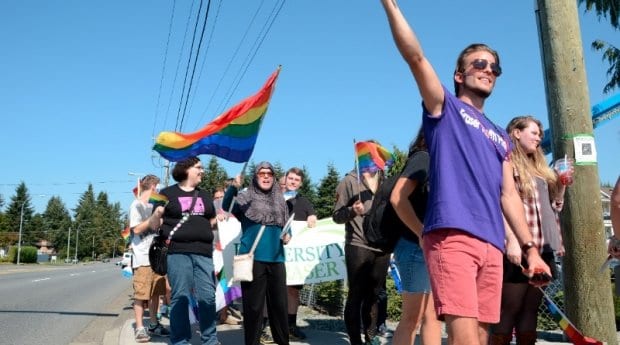“Two, four, six, eight, how do you know your kids are straight?” chanted attendees of the second annual Fraser Youth Pride march, held Sept 21.
The march was part of a larger community event hosted by the Fraser Valley Youth Society (FVYS) to celebrate diversity and promote acceptance. Festivities included music, vendors and youth performances.
“I think the interest definitely has picked up in our own community,” says Samantha Williams, FVYS director of operations. She says the event was much more organized this year and is gaining momentum as a fixture of Abbotsford culture. “I think that it’s important for the kids to know that they are in a community that accepts them,” she adds. “You want them to have fond memories of their childhood growing up.”
While the event was youth-focused, people of all ages and identities showed their support by joining the march and at the following celebration.
Mayor Bruce Banman urged the community to be proactive when it comes to creating an inclusive environment. He stressed that it is up to the community to raise awareness and support. “Abbotsford youth are at the beginning of a lifelong journey; they are beginning to discover who they are and who they could become,” he noted.
The FVYS provides weekly drop-ins across the Fraser Valley, providing a forum for young people to ask questions, explore their identities and find support during a time that for some can be quite isolating.
While the safe space provided by the drop-ins is invaluable, large-scale events like the march show there’s acceptance in the wider community and offers an opportunity for youth to celebrate and be celebrated.
“We need to consistently send a message to the youth here that they’re accepted for who they are,” FVYS board member John Kuipers says. “These are small steps that we can take in our community — doing events like these and just showing up and being inclusive to everyone. That’s what’s really important.”
The BC Civil Liberties Association conferred its Excellence in Youth Activism Award on the FVYS in recognition of the organization’s leadership, dedication and bravery in staging an event that has faced community opposition in the past.
For the youth involved, that persistence has begun to pay off. Mari Silzer has already experienced firsthand a change in her community.
“It raises awareness; it says, ‘Hey, we exist,’” she says.
Silzer recalls a time a few years ago when her mother would describe her as gay, simply because she didn’t understand what transgender meant. For Silzer, having a queer community presence brings attention to people and issues that might be overlooked.
The event is also seen as an effective way to reach out to other LGBT youth who might not be aware of the drop-ins.
“I like spreading the word that we’re actually here,” says Audrey Treacher, “so that people know we’re here and we can get some new faces, some new friends, in the drop-in.”

 Why you can trust Xtra
Why you can trust Xtra


